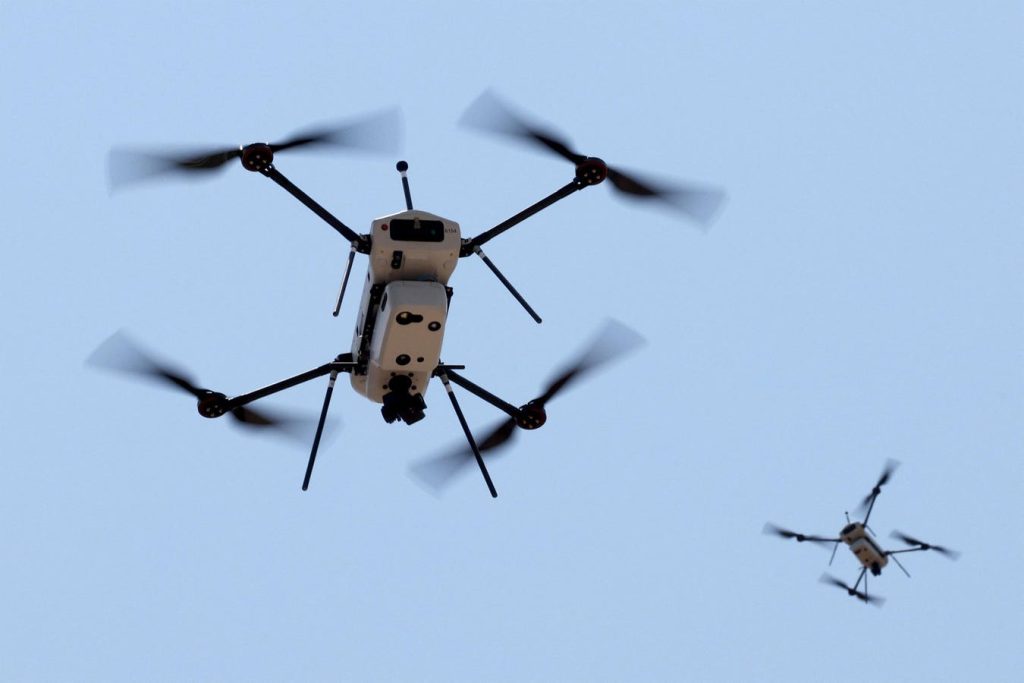Israel’s PM Netanyahu has vowed to eliminate Hamas and IDF ground forces have entered Gaza to seek and destroy militants. Hamas fighters may seek to make their last stand in their labyrinthine tunnel network beneath Gaza, a world of narrow passageways filled with bombs, booby traps and ambush points. The IDF’s Samur (“Weasel”) unit specializes in underground combat, but even this elite unit could take heavy casualties fighting at close range against suicidal Jihadis. Rather than risking humans, the IDF may send in the drones.
Underground Flyers
A tunnel is about the worst possible place to fly a drone. The confined environment is full of obstacles, and any contact can break a rotor blade and disable the drone. Another is that drones generally rely on GPS or other satnav for navigation, which does not work underground. And thirdly, radio waves do not travel through dirt, so the operator will lose contact with a drone as soon as it is out of sight.
Drone developers relish this type of challenge. The first problem can be solved with anti-collision sensors and rotor blades enclosed by protective cages. The other two require a type of smart software known as Simultaneous Location and Mapping or SLAM.
SLAM is a lot like what humans do instinctively when entering an unfamiliar building: we automatically create a mental picture of the place as we go so we can easily find our way around without needing a map. A drone or robot using SLAM builds a 3D model of its environment and tracks its position within that environment. That means it does not need an external navigation reference like GPS to know where it is, nor a human operator to guide it as it explores.
In the commercial world, SLAM-enabled drones from Exyn AI can autonomously map old mine workings. Their setup is literally a pushbutton control which Exyn demonstrated in 2020 by having the drone ‘piloted’ by a dog which only had to press the start button. The drone then carried out a complete autonomous exploration and returned. The system proves a safe way of exploring and mapping hazardous underground spaces without having to send humans.
Exyn say their drones are suitable for exploring the most dangerous places. It is no surprise that the same technology is used for subterranean warfare.
Agents of Shield AI
Technology startup Shield AI is one of the leaders in bringing new artificial intelligence to the defense sector. While Shield is best known for systems to pilot F-16 jets — “With a 99% win-rate in simulated F-16 dogfights versus active-duty Air Force and Navy fighter pilots,” according to the company website – their first products were smaller uncrewed aircraft.
Brandon Tseng is Shield’s President and a co-founder. While serving as a Navy SEAL in Afghanistan Tseng experienced firsthand situations where soldiers were forced to enter compounds and buildings without knowing what or who was inside, and suffered casualties as a result. He founded Shield AI partly to fill that information gap. Nova, the company’s flagship drone, has been in service with US Special Forces since 2018.
Nova 2 is an AI-enabled small drone which can intelligently map and search multi-story indoor buildings and underground complexes without a human operator. It is also able to recognize objects, including humans. According to the company description:
“Nova 2 uses state-of-the-art path planning and computer vision algorithms to autonomously navigate complex subterranean and multi-story buildings without GPS, comms or a human pilot.”
“As Nova 2 autonomously clears, people are detected and auto-populated on a map…Nova 2 builds 3D multi-story maps, providing an unrivaled common operating picture of the battlefield.”
This capability should mean that soldiers always know who is occupying a building or tunnel before they go in.
My Name Is Legion-X
Israel has developed similar capabilities, in particular the Legion-X system made by Elbit Systems which was revealed in an impressive video last year. Legion-X is a flexible system which shares data between multiple robots working together. The system is platform agnostic and has an open architecture, so any number of different drones and robots could be incorporated as needed, in particular these may include the Lanius drones designed for indoor and underground operation.
Lanius is a small quadcopter with combined search and attack capability. The Legion-X video shows a large octocopter drone acting as a mothership to small, sensor-carrying Lanius drones which take off to explore inside an apartment block. In addition to sensors, Lanius can also carry a grenade-sized explosive charge, turning it into a loitering munition which is likely to be highly effective in confined spaces.
The Legion-X swarm has “adaptive, complex, collective behaviors for intelligent movement, decisions, and interactions with the environment” and is capable fully autonomous operation.
Legion-X can include wheeled or legged robots, like the Probot, to support the drones or act as communication relays to maintain contact with drones deep inside a tunnel complex. A mix types would provide a means of exploring underground, and potentially locating and engaging Hamas fighters.
“Sending human soldiers to search and clear those tunnels will take a long time and probably be highly costly,” Zachary Kallenborn, Adjunct Fellow with the Center for Strategic and International Studies (CSIS) Strategic Technology Program, told Forbes. “However, sending drones to scout and carry out strikes means potentially considerably less risk to humans.”
This is assuming, of course, that the system performs as intended. Actual military operations do not follow the same course as promotional videos, and this is new technology.
“Elbit claims that Legion-X is designed for subterranean warfare,” says Kallenborn. “The question will be how well the communication and navigation systems work underground.”
The tunnels will pose many challenges, for example some are reportedly fitted with sold steel blast doors which drones and robots may not be able to tackle. But even if Samur or other troops do have to descend deep beneath Gaza, the machines will be going in ahead.
Read the full article here








